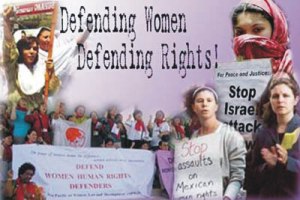Women's
Day Special
Star law history
Tracing
the roots of March 8
Women's
rights
Reclaiming the voices of women
*1857
- one of the first organized actions by working women
anywhere in the world. Hundreds of women garment and textile
workers went on strike in New York City, in protest of
low wages, long working hours and inhumane working conditions.
Police violently attacked the workers, many were injured,
many were arrested.
*1908 - "Bread and Roses" was chanted as a campaign
slogan by some 30,000 women workers who took to the streets
of New York. Bread symbolizing economic security and roses
a better quality of life. The women workers were calling
for shorter work hours, better pay, voting rights and
an end to child labour. Within a few years of their "Bread
and Roses" campaign, the first women's labour union
in America was organized.
* 1911 - working women from Germany, Austria, Denmark
and other European countries held strikes and marches.
Russian revolutionary and feminist Aleksandra Kollantai,
who helped organized the event, described it as "one
seething trembling sea of women." Aleksandra Kollantai
and Klara Zetkin, a German socialist, proposed that there
should be international solidarity among exploited women
workers. Thus, these women have been known to be the founders
of International Women's Day (IWD).
* 1914 - women opposing war staged mass protests all over
Europe. World War I was waged not without dissent from
women. They were organizing and demonstrating for peace,
across cultural divides. This set-off series of powerful
marches and demonstrations all throughout, with women
from both sides of the war participating in solidarity.
* 1917 - The "Bread and Peace" strike led by
the Russian women in St. Petersburg. The IWD strike, which
was participated in by Klara Zetkin and Aleksandra Kollantai,
merged with riots that had spread throughout the city
between March 8-12. This later became known as "The
February Revolution" which forced the authoritarian
rule of Czar Nicholas II to end. (Russia switched from
the Julian to the Gregorian calendar in 1918, which moved
the dates of the February revolution [Feb. 24-28, old
style] to March.)March 8 - "The heroic woman worker"
is commemorated and celebrated on this day, as Aleksandra
Kollantai, as a minister in the first Soviet government,
persuaded Lenin to make March 8 as an official communist
holiday.
 The
history of March 8 as the International Women's Day is
rooted on the movement for women's rights and peace. IWD
was commemorated in the United States during the 1910s
and 1920s, but then dwindled. It was revived during the
women's movement in the 1960s, but without its socialist
associations. In 1975, the United Nations began sponsoring
International Women's Day.
The
history of March 8 as the International Women's Day is
rooted on the movement for women's rights and peace. IWD
was commemorated in the United States during the 1910s
and 1920s, but then dwindled. It was revived during the
women's movement in the 1960s, but without its socialist
associations. In 1975, the United Nations began sponsoring
International Women's Day.
The
women's movements in the Asia Pacific region have long
joined in the celebration of the IWD. While equal rights,
quality of life and peace have been consistently upheld
as the demands of women, there were also other issues
highlighted which are urgent and particular to the lives
and context of women in the region. The use of rape by
the state as a weapon of war has ravaged the lives of
hundreds of women living in armed conflict situations.
The aggressive war on terrorism has heightened violence
against communities and organisations in the list of suspected
terrorists, causing insecurity and death among women human
rights defenders. The take-over of multinational corporations
over land, farms, vegetable gardens, kitchen, has pushed
rural women out of their source of power and control over
their livelihoods and survival. The intensifying fundamentalisms
have seen the use of women and their bodies as tools of
propaganda for different religion and ethnicity, entrenching
masculine power over women and their communities.
However,
over the years, the tradition of the IWD has slowly been
co-opted by the governments. March 8 as the International
Women's Day is increasingly becoming an occasion for UN-sponsored
international conferences, national government-sponsored
festivities and grand receptions. While these help popularise
the significance of March 8, that is to highlight the
urgent issues of women, and a space to create international
solidarity among women, these government grand events
overshadow the genuine spirit of political activism of
IWD.
March
8, as the International Women's Day, has the tradition
of protest and activism. Let us keep it alive. Let us
not allow this day to be a government-sponsored celebration
led by women who enjoy privileges of power and wealth,
while majority of women continue to live a life of poverty,
exploitation and oppression. Let them not speak for us.
Let them not obscure our fight for change.
On
March 8, and the days thereafter on this women's month,
let us take to the streets, as our sisters did generations
ago. Let our own voices be heard today!
The
women's month is also a month of celebration. Let us celebrate
international solidarity among women workers, migrants,
indigenous, hill tribes, rural poor, Dalits, peasants,
fisher and agricultural workers, sex workers, trafficked
girls and other marginalized women. Let us celebrate our
strength, and our spirit, as we persist with our mission
of giving birth to a just, humane, nurturing society for
both women and men.
Source:
Asia Pacific Forum on Women, Law and Development (APWLD).
Photo:
APWLD